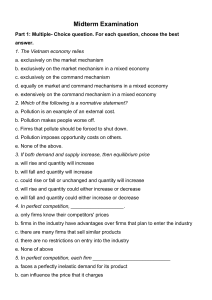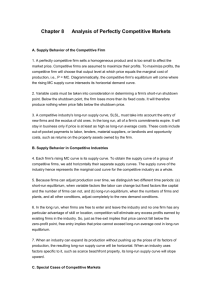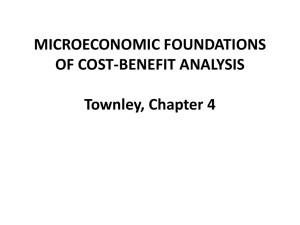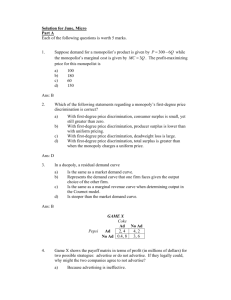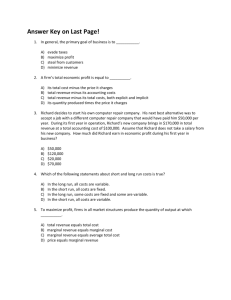CH5: DEMAND AND CONSUMER BEHAVIOR
advertisement
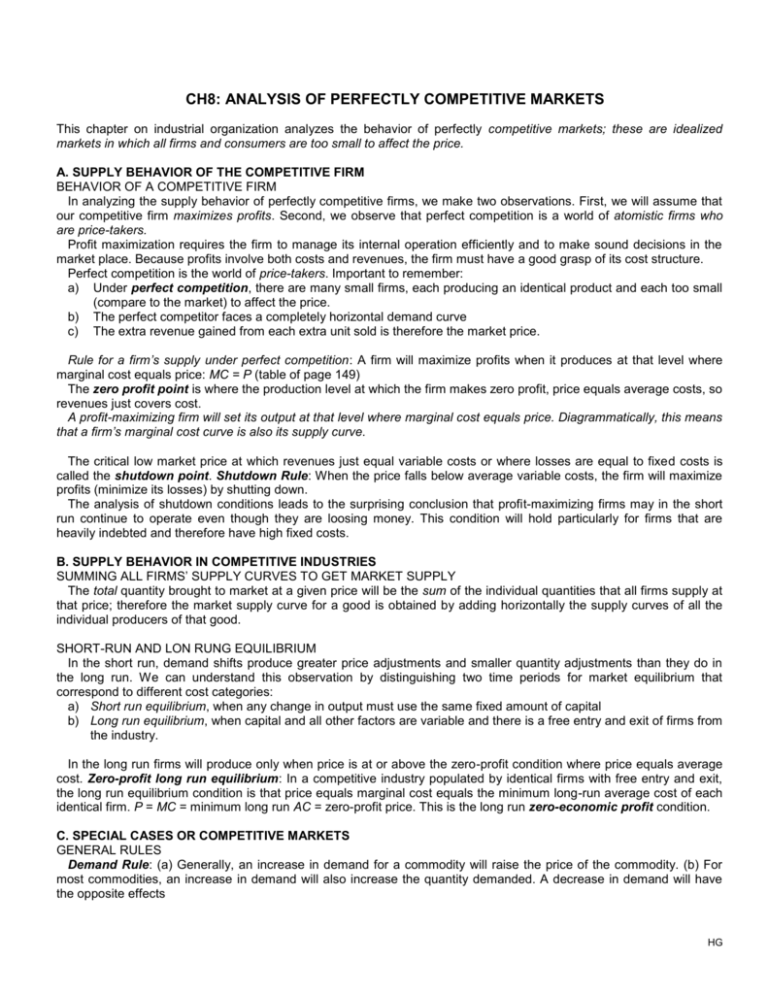
CH8: ANALYSIS OF PERFECTLY COMPETITIVE MARKETS This chapter on industrial organization analyzes the behavior of perfectly competitive markets; these are idealized markets in which all firms and consumers are too small to affect the price. A. SUPPLY BEHAVIOR OF THE COMPETITIVE FIRM BEHAVIOR OF A COMPETITIVE FIRM In analyzing the supply behavior of perfectly competitive firms, we make two observations. First, we will assume that our competitive firm maximizes profits. Second, we observe that perfect competition is a world of atomistic firms who are price-takers. Profit maximization requires the firm to manage its internal operation efficiently and to make sound decisions in the market place. Because profits involve both costs and revenues, the firm must have a good grasp of its cost structure. Perfect competition is the world of price-takers. Important to remember: a) Under perfect competition, there are many small firms, each producing an identical product and each too small (compare to the market) to affect the price. b) The perfect competitor faces a completely horizontal demand curve c) The extra revenue gained from each extra unit sold is therefore the market price. Rule for a firm’s supply under perfect competition: A firm will maximize profits when it produces at that level where marginal cost equals price: MC = P (table of page 149) The zero profit point is where the production level at which the firm makes zero profit, price equals average costs, so revenues just covers cost. A profit-maximizing firm will set its output at that level where marginal cost equals price. Diagrammatically, this means that a firm’s marginal cost curve is also its supply curve. The critical low market price at which revenues just equal variable costs or where losses are equal to fixed costs is called the shutdown point. Shutdown Rule: When the price falls below average variable costs, the firm will maximize profits (minimize its losses) by shutting down. The analysis of shutdown conditions leads to the surprising conclusion that profit-maximizing firms may in the short run continue to operate even though they are loosing money. This condition will hold particularly for firms that are heavily indebted and therefore have high fixed costs. B. SUPPLY BEHAVIOR IN COMPETITIVE INDUSTRIES SUMMING ALL FIRMS’ SUPPLY CURVES TO GET MARKET SUPPLY The total quantity brought to market at a given price will be the sum of the individual quantities that all firms supply at that price; therefore the market supply curve for a good is obtained by adding horizontally the supply curves of all the individual producers of that good. SHORT-RUN AND LON RUNG EQUILIBRIUM In the short run, demand shifts produce greater price adjustments and smaller quantity adjustments than they do in the long run. We can understand this observation by distinguishing two time periods for market equilibrium that correspond to different cost categories: a) Short run equilibrium, when any change in output must use the same fixed amount of capital b) Long run equilibrium, when capital and all other factors are variable and there is a free entry and exit of firms from the industry. In the long run firms will produce only when price is at or above the zero-profit condition where price equals average cost. Zero-profit long run equilibrium: In a competitive industry populated by identical firms with free entry and exit, the long run equilibrium condition is that price equals marginal cost equals the minimum long-run average cost of each identical firm. P = MC = minimum long run AC = zero-profit price. This is the long run zero-economic profit condition. C. SPECIAL CASES OR COMPETITIVE MARKETS GENERAL RULES Demand Rule: (a) Generally, an increase in demand for a commodity will raise the price of the commodity. (b) For most commodities, an increase in demand will also increase the quantity demanded. A decrease in demand will have the opposite effects HG Supply Rule: An increase in supply of a commodity will generally lower the price and increase the quantity bought and sold. A decrease in supply has the opposite effects. Some goods or productive factors are completely fixed in amount, regardless of price. When the qty supplied is constant at every price, the payment for the use of such factor of production is called rent or pure economic rent. Quantity corollaries of the supply curve: a) An increased supply will decrease P most when demand is inelastic b) An increased supply will increase Q least when demand is inelastic D. EFFICIENCY AND EQUITY OF COMPETITIVE MARKET EVALUATING THE MARKET MECHANISM In analyzing an economy, we are centrally concerned with the concept of allocative efficiency or efficiency. Allocative efficiency (or efficiency) occurs when no possible reorganization or production can make anyone better off without making someone else worse off. Under conditions of allocative efficiency; one person’s satisfaction or utility can be increased only by lowering someone else’s utility. One of the most profound results in all economics is that allocation of resources by perfectly competitive markets is efficient. Economic surplus is the sum of the consumer surplus, which is the area between the demand curve and the price line. The producer surplus is the area between the price line and the supply curve. Efficiency implies that economic surplus is maximized, where economic surplus equals consumer surplus + producer surplus. Efficiency comes because: a) P = MU b) P = MC c) Therefore MU = MC. Thus the marginal social cost of producing a good under perfect competition just equals its marginal utility valuation in terms of goods or leisure forgone. It is exactly this condition which guarantees that a competitive equilibrium is efficient The perfectly competitive market is a device for synthesizing a) the willingness of consumer possession dollar votes to pay for goods with b) the marginal costs of those goods as represented by firms’ supply. Under certain conditions, competition guarantees efficiency, in which no consumer’s utility can be raised w/o lowering another consumer’s utility. HG
